


 作者:王记涛 赵文广
作者:王记涛 赵文广
 来源:《中国公路》
来源:《中国公路》
 时间:2023-07-20
时间:2023-07-20
【Research on Application Technology of Low-carbon Construction in The Whole Life Cycle of Mountain Expressways】
(河南金途科技集团股份有限公司,河南 郑州 450000)
摘要:为系统推进高速公路低碳建设应用,本文围绕山区高速公路建设项目的技术特点和需求,按照“紧扣工程特点、贴近建设需求、突出低碳技术”的总体思路,深入贯彻《关于做好交通运输部科技示范工程有关工作的通知》要求,围绕“算碳、降碳、补能、汇碳”四个维度,以全生命周期角度对山区高速公路建设提出相应建议,规划实施降碳成果推广应用。
关键词:山区高速公路;全生命周期;绿色低碳;补能;算碳;降碳
0 引言
面对全球性生态环境恶化、气候变化、能源资源短缺带来的严峻挑战,加快转变交通运输发展建设技术模式创新,是当前的迫切需求。公路工程的节能,是交通运输行业节能降耗的重要环节,是实现绿色交通发展的重要领域。因此,绿色公路建设过程中,应从降低能耗的角度优化公路工程的设计和施工,减少公路工程全寿命周期内的能源消耗。
1 公路全生命周期低碳建设路径
全方位践行全生命周期低碳建设理念,构建”算碳、降碳、补能、汇碳“四个维度考评指标,从多个维度支撑相关战略实施,结合工程实际情况谋划低碳建设路径,针对公路建设过程机械设备、主要建材选用、关键技术工艺等全过程的碳排放,广泛调研国内外碳排放评价方法;针对植被恢复与景观绿化,广泛分析、借鉴并筛选适用于公路绿化的碳汇分析方法;针对路基路面施工期能耗大、污染排放高及运营期开裂、车辙等公路工程建设中的代表性疑难问题,通过高性能材料、设备与耐久、长寿命工艺等节约低碳技术与品质工程技术相融合,围绕零碳服务区建设、隧道绿色爆破技术等单项工程的低碳建造,创新施工工艺。同时,结合过程中低碳评价对材料、工艺选择优化,能源替代优化、生态修复景观绿化植物选择与搭配优化,促进技术应用创新。详细路径如图1所示。
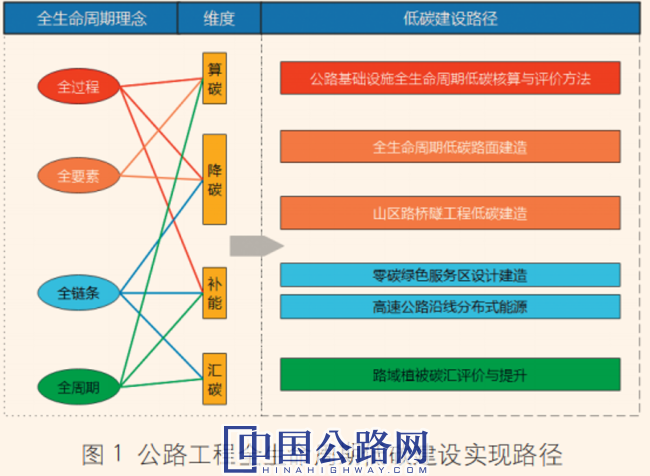
2 量化低碳评价方法
2.1 全生命周期碳排放核算与评价
基于生命周期评价理论,通过分析典型高速公路路段主要碳排放来源,针对河南省公路基础设施建设碳排放核算体系、低碳技术评价方法不明,以及项目全过程高耗能、高排放的底数不清等问题,研究提出覆盖公路规划设计、招投标、施工、竣工验收全过程的低碳管理对策和建造技术,提出高速公路建设全过程碳排放量核算模型,建立高速公路全生命周期碳排放量核算与评价方法,如图2所示,实现对项目节能降碳效果评价,为支撑高速公路节能降碳水平的评价与管理提供技术与理论依据。
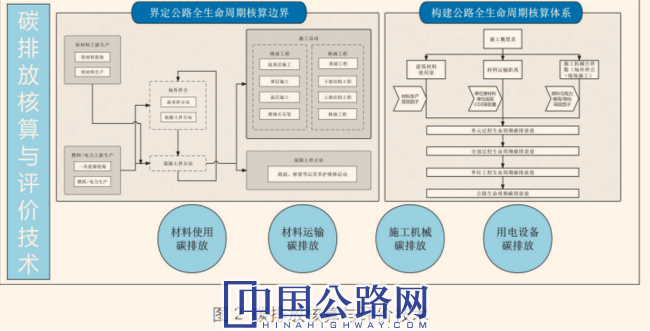
2.2 高速公路路域植被碳汇能力测算与提升技术
在碳汇技术应用的基础上,借鉴国内外林业部门研究成果,结合公路工程实践,通过路域固碳植物配置、路域碳汇管理与提升等核心技术,提出高速公路路域碳汇理念,开展路域植被碳汇能力测算与提升技术应用,包括植被碳汇能力评价、碳汇能力测算及植被碳汇提升等,为建设期及运营期工程的植被恢复管理提供参考,为绿化工程中目标群落配置与植物选择提供优化方案。利用互通区、边坡、中分带等区域,优化绿化物种选择搭配,优化边坡防护型式,推广生态边坡防护技术,不仅可以节约工程造价,提高路域碳汇能力,该技术还可提升路域植被碳汇能力约15%,植被共可固碳约200吨。
3 低碳公路建设应用技术措施
高速公路碳排放源包括资源占用、材料使用和能源消耗三个方面,分为高速公路在建设、运营、养护全寿命周期内直接排放二氧化碳的内源性碳排放和所消耗的钢材、水泥、沥青、电缆、燃油等各类材料在外部工业系统生产中已经排放二氧化碳的外源性碳排放两大类。因此,高速公路减碳路径主要有以下技术应用。
3.1 全生命周期低碳路基路面建造
3.1.1 百年品质工程高性能路基建造技术
项目地形地貌与地质状况复杂,山区公路雨水易汇集,路基高差大,易导致路基差异沉降大,易引起路基路面开裂。通过采用百年品质工程高性能路基建造技术,完善百年品质工程高性能路基的技术指标体系、控制标准与具体技术措施,优化路基填料、施工工艺与机械设备组合,提高路基性能指标,确保路基的整体稳定、控制工后沉降、保障路基强度与耐久性,减少高耗能材料的使用,降低后期养护费用,大幅降低碳排放,降低全寿命周期成本。
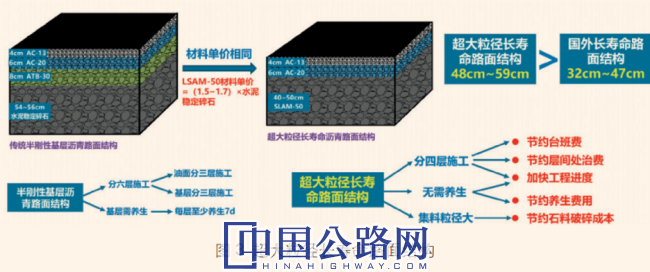
3.1.2 超大粒径长寿命沥青路面研究与工程应用技术
针对高速公路路面半刚性基层开裂问题,开展超大粒径LSAM-50柔性基层材料研究与应用,包括LSAM-50沥青混合料试件制备与性能评价方法研究、超大粒径沥青路面材料模型构建、大粒径沥青路面车轮-路面结构力学模型构建,符合河南省乃至全国交通行业有关长寿命路面的重大战略需求。其力学性能和抗车辙性能相比于常规ATB-30可分别提升40%和450%以上,油石比降低至2.8%,有效提升路面耐久性,减少后期路面养护专项投入。
3.1.3 基于机械发泡装置的沥青路面低碳建造技术
项目沿线生态环境敏感,采用机械发泡温拌沥青技术,将沥青和微量水通过机械发泡装备形成泡沫沥青,增大沥青的表面积,降低沥青结合料的黏度,从而在拌和楼中与粗细集料、矿粉在较低温度下拌和,提高沥青混合料的施工和易性,在保证沥青混合料路用性能的前提下,降低施工温度20℃~40℃,改善施工环境,最大程度的保护沿线生态环境。采用该项技术降低沥青烟排放80%以上,降低二氧化碳排放50%以上。
3.1.4 热拌沥青混合料净味抑烟低排放生产与施工技术
在长大隧道内和环境敏感区,热拌沥青混合料不仅对周边环境造成污染,且容易危害施工人员的身体健康。在沥青拌和过程中添加净味抑烟环保添加剂,并调控其适配性,采用净味剂BPF 可有效改善沥青混合料施工现场的作业条件,对沥青及沥青混合料的路用性能基本无影响,研究净味材料与公路沿线地区工程的材料功能、环境协同,减少对周边生态环境的影响,对硫化氢的降解率可达20%以上,氨氧化物、二氧化硫降解率可达25%以上。
3.2 山区路桥隧工程低碳建造
3.2.1 增效降碳隧道绿色爆破技术
隧道主要位于山岭段,隧道洞身围岩以强风化、中风化岩体为主,洞口段围岩以强风化岩体为主,开展增效降碳绿色隧道爆破技术应用,包括切缝管材质选择、切缝药包炸药量确定、填塞材料和水袋选择、关键炮孔填塞设计和总体爆破设计,保证隧道掘进进尺的同时尽量减少爆破药量,降低爆破对围岩的扰动强度,降低对周边生态环境的影响,通过采用该技术减少炸药消耗量共计2吨,提升炸药爆炸时的能量利用效率,提高隧道爆破掘进进尺约3%,降低隧道空气中的岩粉含量,缩短隧道爆破后的通风时间约6%,改善隧道作业环境。
3.2.2 新型组合结构特大桥低碳设计建造技术
公路景观桥梁多为拱桥、悬索桥、斜拉桥等特殊结构,需解决深水基础支架施工等问题;传统大跨径桥梁混凝土存在用量大、结构自重大,腹板开裂等问题;开展波形钢腹板梁成套技术应用,包括梁拱组合体系与波形钢腹板组合应用、梁拱组合体系吊杆张拉力的确定与优化等,采用该技术中的波形钢腹板预应力技术和梁拱组合体系,主梁结构自重减少约25%,碳排放量降低约10%,节省工程造价约1.1亿元。
3.3 零碳绿色服务区补能建造
开展服务区绿色低碳共享设计建造技术应用,贯彻实施国家交旅融合发展战略,建设开放式服务区,包括服务区功能调整与设施设计优化、出入口建设和共享设施建设、服务区低碳绿色游想空间建设等。通过对服务区功能分布规划和周边地区配套规划相结合,达到与周边旅游资源区域共享的效果,避免设施重复建设投入,充分利用服务区与周边旅游资源邻接的条件,采用服务区服务设施与周边景区点的旅游服务设施功能融合和设施共享技术,完善服务区内部旅游配套服务功能,实现服务区与周边景区互联互动,提升设施共享度约20%,降低服务区及周边景区的建设环境负荷,减少施工过程和设施运行中的能耗和碳排放。
3.4 高速公路沿线分布式能源减碳核算
高速公路服务区、隧道等属于24h全天候耗能单位,对稳定的电能输出需求十分强烈。项目开展分布式光伏、光储一体化技术应用,采用450Wp 单晶硅光伏组件,系统安装总容量为1000KWp,充分利用光伏发电技术优势,最大限度提升服务区、隧道清洁能源开发和利用比例,能有效减少建筑日晒氧化,延长建筑物使用寿命,使用清洁能源,提高高速公路用能自给率,节约高速公路建设运营的全寿命周期成本。
(1)项目结合系统总效率80%及太阳辐射数据,计算每年发电量如年发电量=系统安装容量× 年有效利用小时数×系统总效率=1000KWp×1460.28h×80% =1168224kWh
项目预计第一年的总发电量为1168224度。
按运营期25年估算,运营期内光伏组件的功率呈非线性衰减,第二年设定衰减2%,第3年~25年设定为线性衰减,平均每年衰减0.6%。那么,运营期25年内光伏组件的功率总衰减为20%。假设光伏系统总效率的衰减速率与光伏组件衰减速率完全一致,即逆变器的转换效率没有发生衰减。项目25年发电量约为2683万Wh,年平均发电量约为107.32万Wh。
(2)分布式光伏应用试点项目的节能降碳效果计算如下:
年减碳量=年发电量×电量边际排放因子×10-3;电量边际排放因子参考国家发改委发布的《2019年度减排项目中国区域电网基准线排放因子》,为0.8587(吨二氧化碳/兆瓦时);计算结果为:因分布式光伏发电而产生的减碳量约为23039吨,年平均减碳量约为922吨。
4 结论
本文从高速公路建设的实际出发,融入绿色低碳理念,设计阶段量化低碳评价方法,夯实理论方法基础,保证在设计合理的基础上降碳、减碳,平衡建设成本。施工阶段突破低碳建造技术,创新绿色低碳工艺,开展低碳技术策划与引入,确保材料性能的有效发挥及节能减排,降低工程造价。运营养护阶段探索低碳迭代路径,实现品质低碳双赢,充分挖掘沿线可再生能源的应用,高速公路沿线管理设施分布式能源综合利用技术,建立多能互补集成技术体系,并围绕低碳建设全生命周期技术应用做总结评价。迭代循环技术攻关新课题,推广应用算碳、降碳、汇碳、补能新技术,以期对公路工程低碳建设策略提出相应建议。
参考文献
[1]李峰.低碳高速公路建设研究思路[J].北方交通,2015(02).
[2]许新权,吴传海等.广东省交通科技示范工程管理机制研究[J].广东公路交通,2016(06).
[3]梁远禄,刘佳等.红土地上的绿色路——绿色公路技术在广西高速公路的应用[J].中国公路,2017(21).
[4]李享.建筑全生命周期碳足迹设计分析工具初探[D].西安建筑科技大学,2018.
[5]刘圆圆.基于ALCA的公路生命周期二氧化碳计量理论与方法研究[D].长安大学,2019.
[6]徐建峰.公路隧道施工碳排放计算方法及预测模型研究[D].西南交通大学,2021.
[7]吕指臣,胡鞍钢.中国建设绿色低碳循环发展的现代化经济体系:实现路径与现实意义[J].北京工业大学学报 (社会科学版),2021(6).
[8]把握新发展阶段,贯彻新发展理念,构建新发展格局[EB/OL].2021(4).
[9]李慧,彭夏清等.公路生命周期碳排放评估及其敏感性分析[J].公路工程,2021(02).
[10]王文,刘锦涛等.碳中和与中国未来[M].北京师范大学出版社,2022.
Research on Application Technology of Low-carbon Construction in The Whole Life Cycle of Mountain Expressways
Jitao Wang Wenguang Zhao
(Shang Luo Highway Co.,Ltd.Of Henan Transort Investment Group Co,Ltd,Zhengzhou Henan 450000)
Abstract: Focusing on the technical characteristics and needs of highway construction projects in mountainous areas, in order to systematically promote the application of low-carbon construction of expressways, this paper deeply implements the requirements of the Notice on Doing a Good Job in the Science and Technology Demonstration Project of the Ministry of Transport in accordance with the general idea of "closely following the characteristics of the project, close to the construction needs of construction, and highlighting low-carbon technology", and puts forward corresponding suggestions for the construction of expressways in mountainous areas from the perspective of the whole life cycle around the four dimensions of "carbon calculation, carbon reduction, energy replenishment, and carbon sink", and plans to implement the promotion and application of carbon reduction achievements.
Keywords: Mountain expressway;Full life cycle;Green and low-carbon;Energy replenishment;Carbon calculation;Carbon reduction;Carbon sink
0 Introduction
In the face of the severe challenges brought about by the deterioration of the global ecological environment, climate change and shortage of energy resources, it is an urgent need to accelerate the transformation of transportation development and construction technology model innovation. Energy conservation in highway engineering is an important link between energy conservation and consumption reduction in the transportation industry and an important field for green transportation development. Therefore, in the process of green highway construction, the design and construction of highway engineering should be optimized from the perspective of reducing energy consumption, and energy consumption in the whole life cycle of highway projects should be reduced.
1 Road Life Cycle Low Carbon Construction Path
Implement the concept of low-carbon construction throughout the life cycle in all aspects, build four dimensional evaluation indicators of carbon calculation, carbon reduction, energy replenishment and carbon sink, support the implementation of relevant strategies from multiple dimensions, plan low-carbon construction paths based on the actual situation of the project, and extensively investigate carbon emission evaluation methods at home and abroad for the carbon emissions of the whole process such as machinery and equipment, main building materials selection, and key technologies and processes in the highway construction process; For vegetation restoration and landscape greening, extensive analysis, reference and screening of carbon sink analysis methods suitable for highway greening; In view of the representative and diffcult problems in highway engineering construction such as large energy consumption, high pollution emissions, cracking and rutting during operation, through the integration of high-performance materials, equipment and durable and long-life processes and other low-carbon saving technologies and quality engineering technologies, the construction process is innovated around the low-carbon construction of single projects such as zero-carbon service area construction and tunnel green blasting technology. At the same time, combined with the low-carbon evaluation in the process, the selection and optimization of materials and processes, the optimization of energy substitution, and the selection and matching of green plants for ecological restoration landscape are optimized to promote technological application innovation. The road map is as follows:
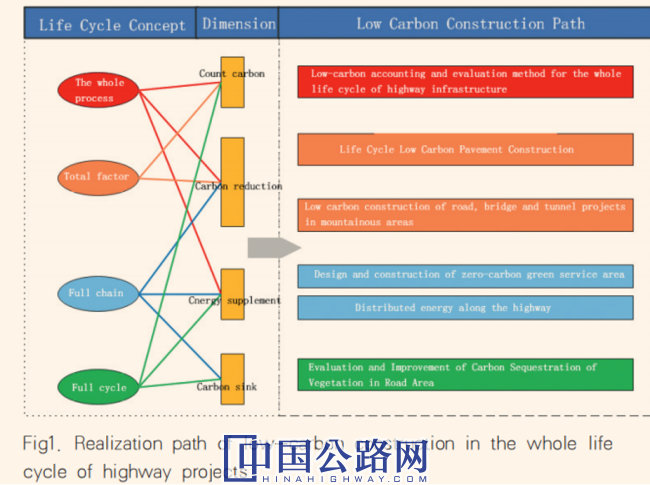
2 Quantitative Low-carbon Evaluation Methods
2.1 Accounting And Evaluation of Carbon Emissions Throughout The Life Cycle
Based on the life cycle assessment theory, by analyzing the main carbon emission sources of typical expressway sections, and aiming at the problems of carbon emission accounting system and low-carbon technology evaluation method for highway infrastructure construction in Henan Province, and unclear bottom line of high energy consumption and high emission in the whole process of the project, this paper studies and proposes low-carbon management countermeasures and construction technologies covering the whole process of highway planning and design, bidding and bidding, construction, completion acceptance, and puts forward a carbon emission accounting model for the whole process of highway construction. Establish a carbon emission accounting and evaluation method for the whole life cycle of expressways (see Fig2) to realize the evaluation of the energy conservation and carbon reduction effect of the project, and provide a technical and theoretical basis for the evaluation and management of the energy conservation and carbon reduction level of expressways.
2.2 Measurement And Improvement Technology of Vegetation Carbon Sink Capacity in Highway Areas
On the basis of the application of carbon sink technology, drawing on the research results of forestry departments at home and abroad, combined with the practice of highway engineering, through the core technologies such as road area carbon sequestration plant configuration and road area carbon sink management and improvement, the concept of highway road carbon sink is proposed, and the application of road vegetation carbon sink capacity measurement and improvement technology is carried out, including vegetation carbon sink capacity evaluation, carbon sink capacity measurement and vegetation carbon sink improvement, etc., to provide a reference for vegetation restoration management during the construction and operation periods, and provide optimization schemes for target community configuration and plant selection in greening projects. The use of interconnection areas, slopes, middle zones and other areas to optimize the selection and matching of green species, optimize slope protection types, and promote ecological slope protection technology can not only save project costs and improve the carbon sink capacity of road areas. Through the application of this technology, the carbon sink capacity of vegetation in the road area is increased by about 15%, and the vegetation can sequester a total of about 200 tons of carbon.
3 Application of Technical Measures for Low-carbon Highway Construction
Expressway carbon emission sources include three aspects: resource occupation, material use and energy consumption, which are divided into two categories: endogenous carbon emissions that directly emit carbon dioxide during the whole life cycle of construction, operation and maintenance of expressways, and carbon dioxide exogenous carbon emissions that have been emitted in the production of external industrial systems of various materials such as steel, cement, asphalt, cables, and fuel oil. Therefore, the highway carbon reduction path mainly has the following technical applications.
3.1 Low-carbon Roadbed And Pavement Construction Throughout The Life Cycle
3.1.1 Centennial quality engineering high-performance roadbed construction technology
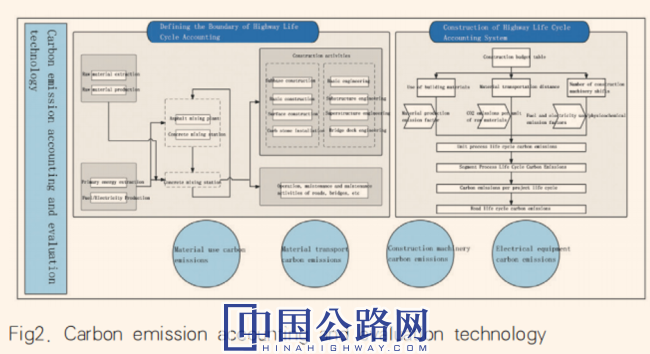
The topography and geological conditions of the project are complex, and the rainwater of mountainous roads is easy to collect, and the height difference of the roadbed is large, which is easy to lead to the settlement of the roadbed difference and the cracking of the roadbed pavement. The high-performance subgrade construction technology of the century-old quality project helps improve the technical index system, control standards and specific technical measures of the high-performance roadbed of the centennial quality project, optimize the combination of subgrade filler, construction technology and mechanical equipment, improve the performance index of the subgrade, ensure the overall stability of the subgrade, control post-construction settlement, ensure the strength and durability of the subgrade, reduce the use of high-energy-consuming materials, reduce the later maintenance costs, greatly reduce carbon emissions, and reduce the cost of the whole life cycle.

3.1.2 Research and engineering application technology of ultra-large particle size and long-life asphalt pavement
Aiming at the cracking of semi-rigid base layer of highway pavement, the research and application of ultra-large particle size LSAM-50 flexible base layer materials were carried out, including the research on the preparation and performance evaluation method of LSAM-50 asphalt mixture specimens, the construction of ultra-large particle size asphalt pavement material model, and the construction of large particle size asphalt pavement wheel-pavement structure mechanical model, which greatly reduced the occurrence of reflection cracks in the later stage and met the major strategic needs of long-life pavement in Henan Province and even the national transportation industry. Compared with conventional ATB-30, the mechanical properties and rutting resistance of this technology can be increased by more than 40% and 450%, respectively, and the oil-stone ratio can be reduced to 2.8%, which effectively improves the durability of the pavement and reduces the special investment in later pavement maintenance.
3.1.3 Low-carbon construction technology of asphalt pavement based on mechanical foaming device
The ecological environment along the project is sensitive, the use of mechanical foaming warm mix asphalt technology, asphalt and trace water through mechanical foaming equipment to form foamed asphalt, increase the surface area of asphalt, reduce the viscosity of asphalt binder, so that it can be mixed with coarse and fine aggregates, mineral powder, etc. in the mixing building at a lower temperature, improve the construction and workability of asphalt mixture, reduce the construction temperature by 20-40°C under the premise of ensuring the road performance of asphalt mixture, improve the construction environment, and protect the ecological environment along the line to the greatest extent. This technology enables the reduction of asphalt smoke emissions by more than 80% and CO2 emissions by more than 50%.
3.1.4 Production and construction technology of hot mix asphalt mixture with clean odor, smoke suppression and low emission
In the long tunnel and the environmentally sensitive area, the hot mix asphalt mixture not only pollutes the surrounding environment, but also endangers the health of the construction personnel. In the asphalt mixing process, add odor and smoke suppression environmental protection additives, and regulate its adaptability, the use of odor purifer BPF can effectively improve the operating conditions of asphalt mixture construction site, basically have no effect on the road performance of asphalt and asphalt mixture, study the material function and environmental synergy between the clean odor material and the project along the highway, reduce the impact on the surrounding ecological environment, the degradation rate of hydrogen sulfde can reach more than 20%, and the degradation rate of ammonia oxide and sulfur dioxide can reach more than 25%.
3.2 Low-carbon Construction of Road, Bridge And Tunnel Projects in Mountainous Areas
3.2 Low-carbon Construction of Road, Bridge And Tunnel Projects in Mountainous Areas
The tunnel is mainly located in the mountain section, the surrounding rock of the tunnel body is mainly strongly weathered and moderately weathered rock mass, and the surrounding rock of the cave entrance section is mainly strongly weathered rock mass, and the application of green tunnel blasting technology for efficiency reduction and carbon reduction is carried out, including the selection of the material of the cutting pipe, the determination of the explosive amount of the cutting package, the selection of flling materials and water bags, the flling design of key gun holes and the overall blasting design, etc., to ensure that the tunnel boring is advanced while minimizing the amount of blasting charge, reducing the disturbance intensity of blasting on the surrounding rock, and reducing the impact on the surrounding ecological environment. This technology reduces the consumption of explosives by a total of 2 tons, improves the energy utilization efficiency when explosives explode, increases the tunnel blasting and excavation by about 3%, reduces the rock powder content in the tunnel air, shortens the ventilation time after tunnel blasting by about 6%, and improves the tunnel operating environment.
3.2.2 Low-carbon design and construction technology of new composite structure special bridge
Highway landscape bridges are mostly realized by special structures such as arch bridges, suspension bridges, cable-stayed bridges, etc., which need to solve problems such as deep-water foundation support construction, which is difficult to construct and has poor environmental protection; Traditional large-span bridges have problems such as large amount of concrete, structural self-weight, and web cracking. Carry out the complete set of technical application of corrugated steel web beam, including the combined application of beam and arch combination system and corrugated steel web, determination and optimization of boom tension of beam and arch combination system, etc. The corrugated steel web prestressing technology and beam arch combination system in this technology realize the self-weight reduction of the main beam structure by about 25%, the carbon emission reduction of about 10%, and the saving of about 110 million yuan in project cost.
3.3 Replenishment Construction of Zero-carbon Green Service Area
Carry out the application of green and low-carbon shared design and construction technology in service areas, implement the national development strategy of integration of transportation and tourism, build open service areas, including service area function adjustment and facility design optimization, entrance and exit construction and shared facility construction, service area low-carbon green imagination space construction, etc., through the combination of service area function distribution planning and surrounding area supporting planning, to achieve the effect of sharing with surrounding tourism resource areas, avoid duplicate construction investment of facilities, and make full use of the conditions of adjacency between service areas and surrounding tourism resources. Adopt the functional integration and facility sharing technology of tourism service facilities between service facilities in the service area and surrounding scenic spots, improve the internal tourism supporting service functions of the service area, realize the interconnection and interaction between the service area and the surrounding scenic spots, improve the sharing degree of facilities by about 20%, reduce the construction environmental load of the service area and surrounding scenic spots, and reduce energy consumption and carbon emissions in the construction process and facility operation.
3.4 Carbon Reduction Accounting for Distributed Energy Resources Along Highways
Highway service areas, tunnels, etc. belong to 24-hour all-weather energy consumption units, and the demand for stable power output is very strong. The project carries out the application of distributed photovoltaic, photovoltaic-storage integration technology, adopts 450Wp monocrystalline silicon photovoltaic modules, and the total installed capacity of the system is 1,000KWp, making full use of the advantages of photovoltaic power generation technology, maximizing the proportion of clean energy development and utilization in service areas and tunnels, effectively reducing building sun oxidation, extending the service life of buildings, using clean energy, improving the self-sufficiency rate of highway energy use, and saving the life-cycle cost of highway construction and operation.
(1) The project combines the total efficiency of the system with 80% and solar radiation data to calculate the annual power generation as follows:
Annual power generation = system installed capacity × annual effective utilization hours× total system effciency = 1,000KWp×1,460.28h×80% = 1,168,224kWh
The project is expected to generate a total of 1,168,224 kWh in the frst year.
According to the operation period of 25 years, the power of photovoltaic modules during the operation period is nonlinear attenuation, the attenuation is set to 2% in the second year, and the linear attenuation is set in the 3~25th year, with an average annual attenuation of 0.6%. Then, the total power attenuation of the PV module during the 25-year operation period is 20%. And assume that the attenuation rate of the total efficiency of the PV system is exactly the same as the attenuation rate of the PV module, that is, the conversion efficiency of the inverter is not attenuated. The power generation of the project in 25 years is about 26,829,818 kWh, and the average annual power generation is about 1,073,193 kWh.
According to the operation period of 25 years, the power of photovoltaic modules during the operation period is nonlinear attenuation, the attenuation is set to 2% in the second year, and the linear attenuation is set in the 3~25th year, with an average annual attenuation of 0.6%. Then, the total power attenuation of the PV module during the 25-year operation period is 20%. And assume that the attenuation rate of the total efficiency of the PV system is exactly the same as the attenuation rate of the PV module, that is, the conversion efficiency of the inverter is not attenuated. The power generation of the project in 25 years is about 26,829,818 kWh, and the average annual power generation is about 1,073,193 kWh.
Annual carbon reduction = annual power generation × electricity marginal emission factor ×10-3; the electricity marginal emission factor refers to the 2019 Annual Emission Reduction Project China Regional Power Grid Baseline Emission Factor issued by the National Development and Reform Commission, which is 0.8587 (tons of carbon dioxide/MWh); The calculation results are: the carbon reduction due to distributed photovoltaic power generation is about 23,039 tons, and the annual average carbon reduction is about 922 tons.
4 Conclusion
Starting from the reality of highway construction, this paper integrates the concept of green and low-carbon, quantifes the low-carbon evaluation method in the design stage, consolidates the theoretical method, and ensures that the carbon reduction and carbon reduction benefits are considered on the basis of reasonable design, and the construction cost is balanced. In the construction stage, breakthroughs are made in low-carbon construction technology, green and low-carbon technology is innovated, and low-carbon technology is planned and introduced in combination with the actual situation of the project to ensure the effective play of material performance and the improvement of energy-saving effect in the process of material use, and reduce project cost. Explore low-carbon iterative paths in the operation and maintenance stage, achieve a win-win situation of quality and low carbon, fully tap the application of renewable energy along the route, comprehensively utilize the technology of distributed energy resources for management facilities along the highway, establish a multi-energy complementary integrated technology system, and summarize and evaluate the carbon emissions of low-carbon highways around the application of low-carbon construction full life cycle technology. Iterative circular technology tackles new topics, promotes the application of new technologies of carbon calculation, carbon reduction, carbon sink and energy replenishment, and puts forward corresponding suggestions for low-carbon construction strategies for highway projects.
References
[1] Feng Li. Research ideas of low-carbon highway construction[J].Northern Transportation,2015(02).
[2] Xinquan Xu, Chuanhai Wu, et al. Research on management mechanism of Guangdong Province Transportation Science and Technology Demonstration Project[J].Guangdong Highway and Transportation,2016(06).
[3] Yuanlu Liang, Jia Liu, et al. Green road on red soil——Application of green highway technology in Guangxi Expressway[J].China Highway,2017(21).[4] Xiang Li. A preliminary study on the design and analysis tool of carbon footprint of the whole life cycle of buildings[D].Xi'an University of Architecture and Technology,2018.
[5] Yuanyuan Liu. Research on the theory and method of highway life cycle carbon dioxide measurement based on ALCA[D].Chang'an University,2019.
[6] Jianfeng. Xu Research on carbon emission calculation method and prediction model of highway tunnel construction[D].Southwest Jiaotong University,2021.
[7] Zhichen Lü, Hu Angang. China's construction of a modern economic system with green and low-carbon circular development:the path and practical significance of it[J].Journal of Beijing University of Technology(Social Science Edition),2021(6).
[8] Grasp the new development stage, implement the new development concept, and build a new development pattern[EB/OL].2021(4).
[9] Hui Li, Xiaqing Peng, et al. Highway Life Cycle Carbon Emission Assessment and Sensitivity Analysis[J].Highway Engineering,2021(02).
[10] Wen Wang, Jintao Liu, et al. Carbon neutrality and China's future[M].Beijing Normal University Press,2022.
【编辑: 任 燕】
 中国公路
中国公路
 中国高速公路
中国高速公路